Can I Register A Domain Name Directly With Icann
There are millions of websites, all with unique domain names. In such a crowded market, you lot may notice that somebody else already owns and is using a domain for which you have the trademark. They may fifty-fifty be using it to inconvenience or disrupt your concern in some way.
If that is the case, you lot might need to file a domain dispute. This is a procedure where you can appeal to an independent arbiter using the Uniform Domain Name Dispute Resolution Policy (UDRP). The goal of this policy is to help trademark holders claim domains that they have a right to employ.
In this article, nosotros'll do a deep dive into the globe of domain disputes. We'll introduce you lot to the UDRP and discuss when you lot might exist able to offset a domain dispute. Finally, we'll talk about what you'll need to do to gear up and how to become started.
And recollect: nosotros're web hosting experts — not lawyers. This guide is meant to be an educational resource to help yous learn more most the domain dispute process. You lot should definitely consult your ain chaser for advice relevant to your specific situation.
Now, let's get into the nitty-gritty of digital turf wars.
An Introduction to Domain Disputes
As yous can probably guess, a domain dispute occurs when multiple parties claim the right to utilize a particular generic top-level domain proper name. This includes .com, .net, and .org (among others).
A common example is when ane party is using a domain that contains a trademark owned by the other party. This practice is commonly known as cybersquatting. In these cases, people purchase domains that stand for to brands they are not affiliated with in club to steal away some of their traffic.
Another related practice is typosquatting, where a person buys domains that are very like to another with a slight variation in spelling. For example, a well-known phishing site used a variation on google.com, which meant they received plenty of traffic from users incorrectly trying to access the search engine.
In that location are numerous reasons people engage in these practices. Naturally, money is a significant factor. Dorsum in the twenty-four hour period, if you managed to buy a domain earlier the trademark owners had the chance to do so, you could sell information technology back to them at a higher cost.
Notwithstanding, domain disputes tin as well arise for even more malicious reasons. For example, a user could buy a domain to inconvenience a particular brand, to compete with them, or fifty-fifty to impersonate them.
The domain dispute process was created to resolve these kinds of cases. Information technology enables trademark holders to contest ownership of domains that are used past others by proving that they have a right to apply the domain and that the other party is using it in bad faith.
How the Domain Name Dispute System Works
In order to process the types of domain disputes discussed above, the Uniform Domain Name Dispute Resolution Policy (UDRP) was born. This policy was created past the Internet Corporation for Assigned Names and Numbers (ICANN) to resolve disputes where multiple parties claim the right to a specific domain.
If you find that somebody else is using a domain that infringes on your trademark or you believe the current holder has bought the domain in bad faith, and then you might be able to file a UDRP to start a dispute proceeding.
While it may sound subjective, bad faith is an important cistron in determining the outcome of a UDRP proceeding. It tin include cases of cybersquatting and typosquatting or instances when the domain holder appears to accept the intention of disrupting or inconveniencing the trademark holder.
Bad religion tin also refer to instances where the domain owner profits off the trademark. For example, if you managed to purchase the domain mcdonalds.com and used it to redirect traffic to your competing hamburger restaurant's website, that would be a clear case of bad faith.
In contrast, there are cases where a disputed domain is found to be bought in proficient faith. This could occur if the owner has a legitimate reason for using the domain — for example, if two businesses have the same (or like) names. Information technology tin can also include cases where the domain owner is using the name non-commercially.
When a domain dispute is opened, it volition be looked at by an independent czar accredited past ICANN. It's important to note that these arbiters can only resolve disputes regarding pinnacle-level domains that are registered with ICANN. In addition, a UDRP proceeding may not exist plenty to settle certain disputes, and yous might still need to engage in negotiation with the other party or settle the matter in court.
Finally, some countries exercise not adhere to the UDRP rules. Instead, they have dissimilar means of dealing with domain disputes. And then brand sure you understand what rules and policies use in your region before going down this route.
What You Demand to Practice Before Starting a Domain Dispute
For your domain dispute to succeed, you'll need to be able to substantiate your claim. As such, y'all'll accept to supply proof that supports your right to the domain in question.
According to the policy as outlined past ICANN, a claimant must exist able to prove all of the following:
- The disputed domain name is identical or confusingly similar to a trademark or service mark in which the complainant has rights.
- The domain owner has no rights or legitimate interests in respect of the domain name.
- The domain name has been registered and is beingness used in bad religion.
As such, you volition beginning need to evidence your ownership of the trademark. How you deal with the remaining claims volition naturally vary depending on each case. However, it's worth researching the current domain possessor to encounter if they regularly snatch upward domains for malicious purposes. If they have such a history, information technology will be easier to testify that they've acted in bad organized religion.
What Constitutes Bad Organized religion
Whether or not the domain possessor has acted in bad religion may sometimes be obvious — for example, if they are using the domain in a way that obviously undermines or profits off of your trademark. However, things may not ever exist so clear, and you'll yet need to exist able to bear witness that bad faith exists in social club for your claim to be accepted.
As per paragraph 4(b) of the policy, evidence of bad faith tin include the following:
- Circumstances indicating that the domain holder registered or acquired the domain name primarily for the purpose of selling, renting, or otherwise transferring the registration to the owner of the trademark (or one of their competitors) in excess of the amount they spent on initially purchasing it.
- The domain holder has registered the domain proper noun to prevent the owner of the trademark from reflecting the mark in a respective domain name.
- They have registered the domain name primarily for the purpose of disrupting the business of a competitor.
- They have used the domain name to attempt to attract users to their site or other online location for commercial gain past purposefully creating defoliation.
As we mentioned, how you prove that the domain owner has acquired the name for any of these reasons will depend on the situation. However, nosotros recommend that you provide every bit much prove to support your case every bit possible. There have been numerous disputes where the complainant lost the example considering they lacked potent supporting evidence that the domain owner had indeed acted in bad religion.
Other Preparations to Make Earlier Filing a UDRP Merits
Before nosotros motion on to talking almost the practical realities of submitting a claim, allow'southward await at some a few other important aspects you'll desire to consider first.
First and foremost, yous'll need to be aware of the fees for submitting a dispute claim. For instance, if you submit your case to Globe Intellectual Property Organization (WIPO), one of ICANN's approved dispute resolution service providers, the toll will vary depending on the number of domains that are included in the merits. For 1–5 domains, you'll need to pay $1,500, which is split between the panelist who deals with your claim and the WIPO.
Bear in heed that you lot will take to provide payment when submitting your claim. For that reason, you need to make certain you tin can pay the full amount before you proceed with any other aspect of the process.
You should also take some time to familiarize yourself with the UDRP rules. These rules outline all aspects of a domain dispute, and they're used to determine the issue. Every bit such, yous need to make sure that yous understand and follow them throughout the procedure.
Once y'all have your case ready to get, with all the supporting evidence in place, y'all'll be able to actually start the domain dispute. Let'southward take a look at how you can become almost that.
How to Begin a Domain Dispute
At this point, you should have a case ready to submit. Fortunately, WIPO has fabricated the procedure a lot easier by providing a Model Complaint form. This is effectively a template you can use to submit your claim, which volition ensure that you include all the necessary data in the required format.
You tin download the model complaint as a Word document, which you tin can fill out and transport as an electronic mail attachment to domain.disputes@wipo.int.
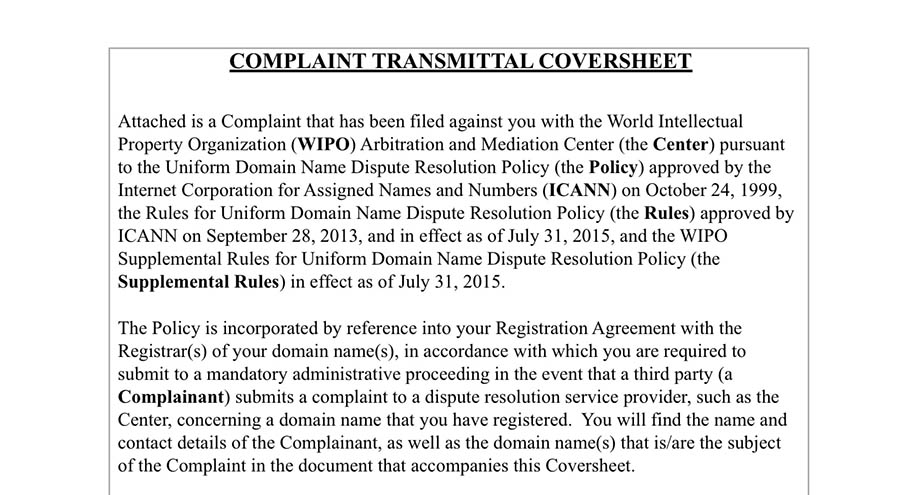
However, you tin can besides apply the online course version, which you can find on WIPO's site.
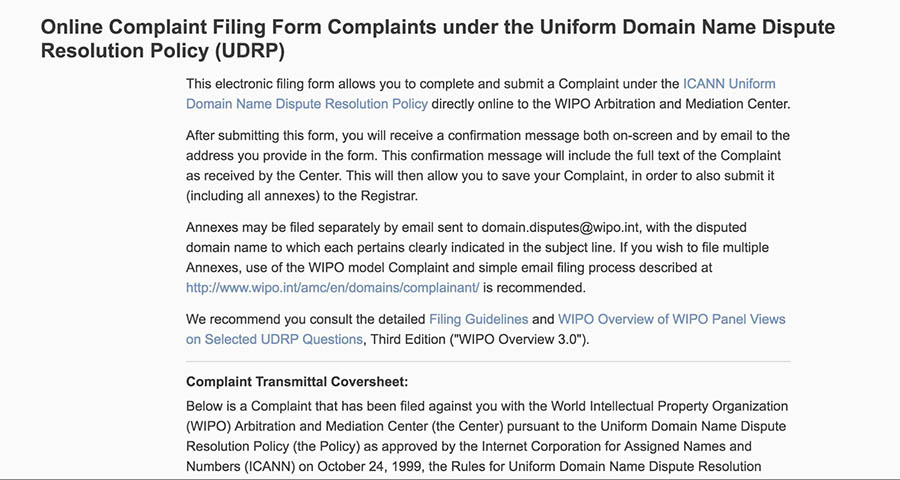
The form itself consists of several sections with the required fields clearly marked. However, any information you lot tin can provide that will back up your merits should exist included, regardless of whether it's listed as required or not. Think that you need to have a stiff, waterproof example, then don't skip over anything at this phase.
The commencement section of the course lays out the basic details for the complainant, respondent, and disputed domains.
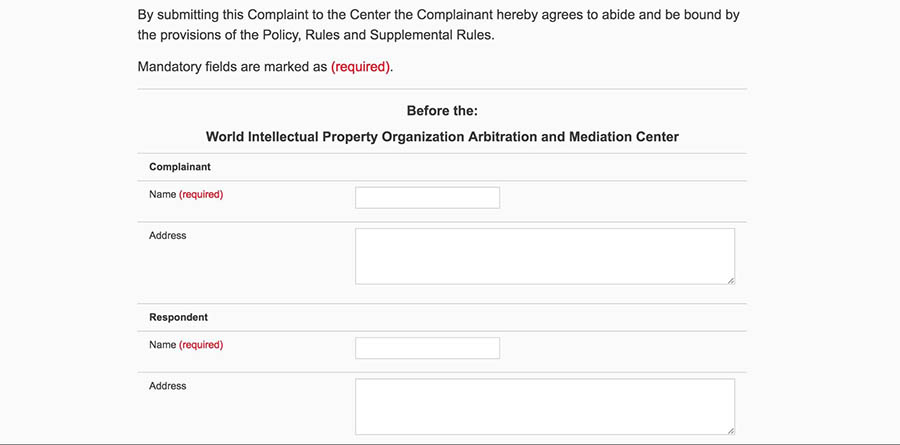
This is where you'll specify your proper name and address, also as those of the domain owner. It's too here where you'll betoken what the domain(s) the dispute concerns.
Later this, you lot'll be asked to supply your contact details and name your representative (if you're using one).
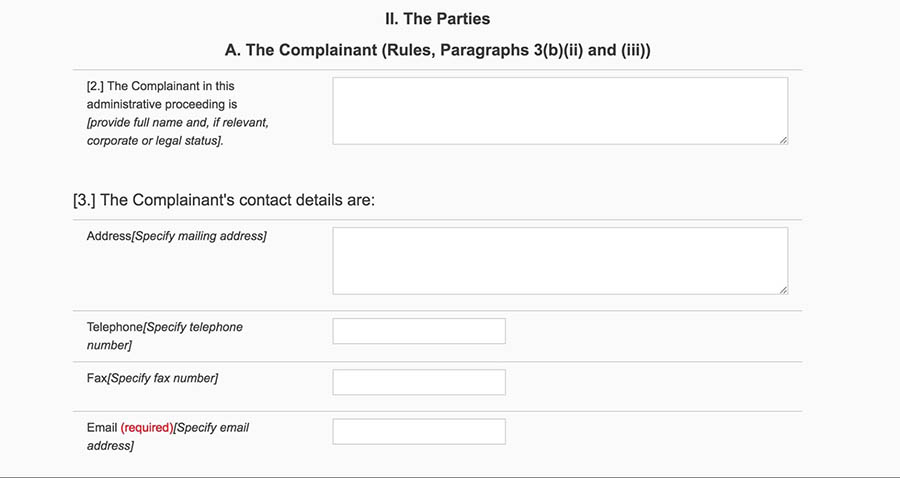
Yous'll also be asked to provide the same details for the domain owner, including what the disputed domains are, which registrar they used to larn them, and ideally the date when they did so.
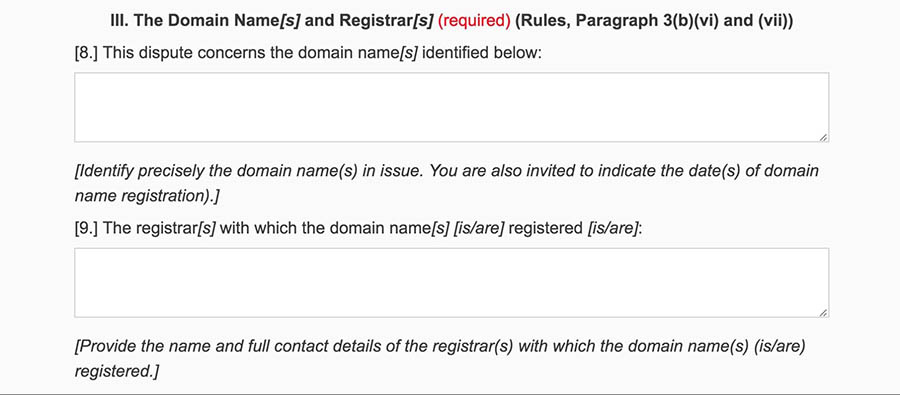
This is followed by optional sections that enable you to specify the linguistic communication yous want to be used in the proceedings, and state the jurisdictional basis for the merits.
Later these sections, you'll exist required to provide the factual and legal grounds by which you lot take a right to utilise the specified domain(s).
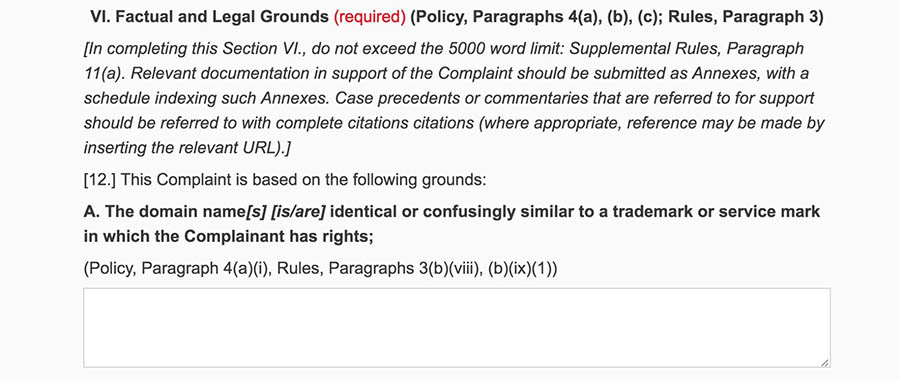
Brand certain that yous follow all the rules and guidelines we outlined earlier to support your claim here. This is a crucial aspect of the process and failing to adequately bear witness your point could crusade the panelists to determine in your opponent's favor.
Side by side, you'll be asked to specify what action you are seeking in regards to the domain. You tin can choose if you desire the domain possessor to transfer the domain to you or if y'all want them to cancel it altogether.
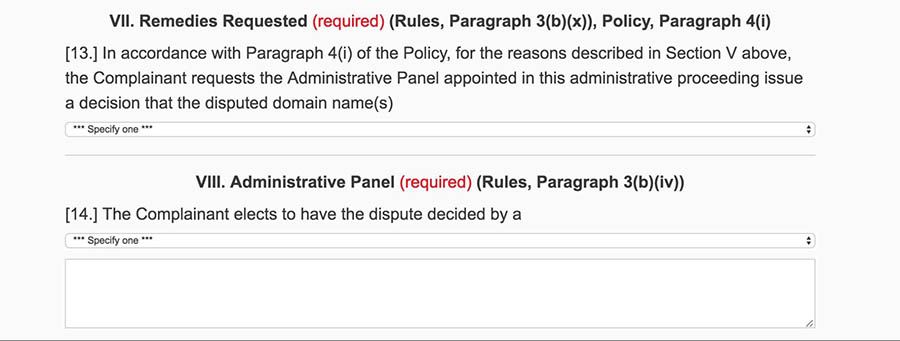
You'll too be able to select if you want one or three panelists to decide your case. Bear in mind that choosing the latter selection will mean a college fee.
The remaining sections are shorter and simpler, so let's run through them quickly:
- Common Jurisdiction : This indicates a courtroom jurisdiction, which could be either the principal office of the registrar or the domain proper name holder'southward accost at the time the complaint is submitted.
- Other Legal Proceedings: This enables you to specify other legal actions that are related to the disputed domains.
- Communications: Here, yous'll need to confirm that you have made the domain owner aware of the complaint.
- Payment: In this section, you'll confirm that you have submitted payment for the claim, along with which method you lot used.
- Certification: This is a purely informative section, asking yous to confirm that the details you take provided are correct to your best knowledge.
- Annexures: Here, yous can supply additional supporting prove in the grade of appendices. You can attach a maximum of 10 annexures with your claim.
Finally, you'll exist asked to sign and confirm your claim.
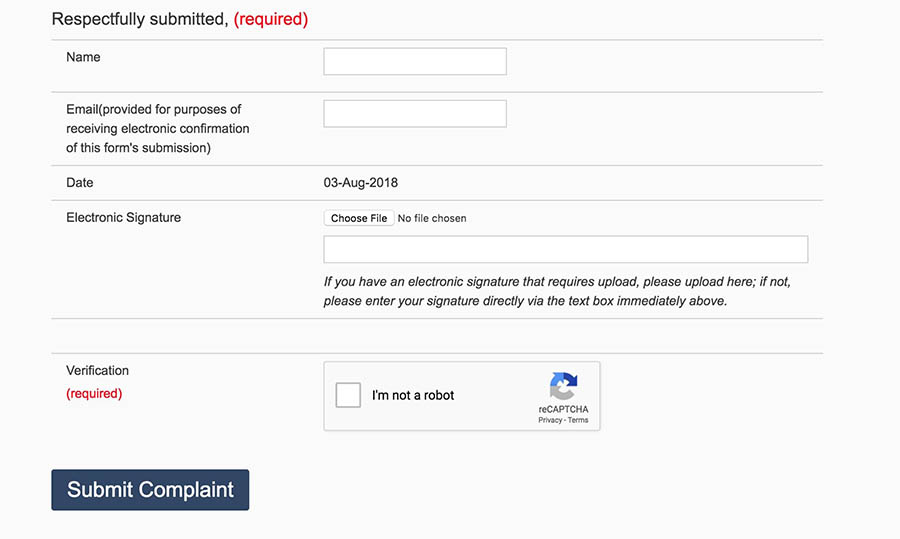
In one case the WIPO has received your complaint, the proceedings volition typically be completed within 60 days. For a more detailed timeline of the process, this breakdown should give you a clearer picture of what to wait.
Your Idea Starts with a Great Domain
Don't let someone else annals your URL. Search DreamHost's 400+ TLDs to detect the perfect fit for your website.

What's in a Domain Proper name?
If you notice someone else is using a domain that you believe should be yours, especially if they're doing so for malicious purposes, you lot may be able to practice something about information technology. This is why the UDRP was created — to solve trademark infringement cases when it comes to domain names. The domain dispute process can be somewhat tricky to navigate as a newcomer, but information technology'due south also worth information technology in the long run.
Practise y'all take any questions about the domain dispute procedure? Join the DreamHost Community and permit'southward discuss!
Can I Register A Domain Name Directly With Icann,
Source: https://www.dreamhost.com/blog/guide-to-icann-domain-dispute/
Posted by: garciasearattables.blogspot.com


0 Response to "Can I Register A Domain Name Directly With Icann"
Post a Comment